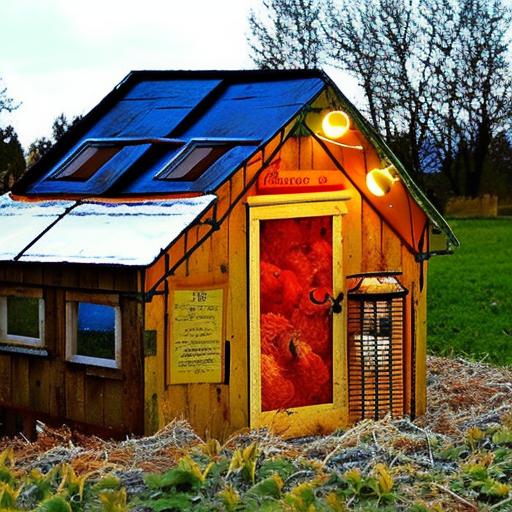Keeping chickens warm during the winter months is crucial for their health and well-being. Cold weather can have negative effects on chickens, such as decreased egg production, increased susceptibility to illness, and even death. To address this issue, Cozy Coops offers innovative solutions for keeping chickens warm without the need for electricity.
Cozy Coops provides a range of products and designs that are specifically tailored to meet the needs of chickens in different climates. Their goal is to create a cozy environment for your flock, ensuring their comfort and safety during the colder months. By understanding the importance of warmth for chickens, choosing the right coop design, insulating the coop effectively, balancing warmth and fresh air, and using alternative heating methods, you can provide your chickens with a comfortable and cozy living space.
Key Takeaways
- Cozy Coops offer a way to keep chickens warm without electricity.
- Warmth is crucial for the health and well-being of chickens.
- Choosing the right coop design for your climate is important.
- Insulating your coop with the right materials and techniques is key.
- Balancing warmth and fresh air through ventilation is essential.
Understanding the Importance of Warmth for Your Chickens
Chickens are naturally adapted to withstand a wide range of temperatures, but they still require warmth during the winter months. Cold weather can have several negative effects on chickens. Firstly, it can lead to decreased egg production. Chickens need a certain amount of warmth to maintain their body temperature and produce eggs consistently. When they are exposed to cold temperatures for extended periods of time, their bodies divert energy away from egg production towards keeping warm.
In addition to decreased egg production, cold weather can also increase the risk of illness in chickens. Just like humans, chickens are more susceptible to respiratory infections when they are exposed to cold and damp conditions. This is because their immune systems are compromised when they have to use energy to keep warm instead of fighting off infections.
Lastly, extreme cold can even lead to death in chickens. If they are not provided with adequate warmth and shelter, chickens can suffer from hypothermia and frostbite. This is especially true for young chicks and older birds who may have a harder time regulating their body temperature.
Choosing the Right Coop Design for Your Climate
When it comes to keeping chickens warm during the winter, choosing the right coop design is crucial. The design of the coop should take into consideration the climate in which you live. Factors to consider include the average winter temperatures, wind patterns, and precipitation levels.
For colder climates with harsh winters, a coop with a smaller footprint and a lower ceiling height is recommended. This helps to trap heat inside the coop and prevent drafts. Additionally, a coop with insulated walls and a well-sealed roof will provide extra protection against the cold.
In milder climates, a larger coop with more ventilation may be suitable. This allows for better air circulation and prevents moisture buildup, which can lead to respiratory issues in chickens. However, it is still important to provide some form of insulation to protect against sudden drops in temperature.
Insulating Your Coop: Materials and Techniques
| Material | Pros | Cons |
|---|---|---|
| Straw | Easy to find and replace, good insulation | Can be messy, attracts pests |
| Hay | Good insulation, readily available | Can be expensive, attracts pests |
| Shavings | Good insulation, easy to clean | Can be expensive, not as readily available |
| Foam board | Excellent insulation, easy to install | Expensive, can be difficult to cut to size |
| Bubble wrap | Good insulation, inexpensive | Not as durable, can be difficult to install |
Insulating your coop effectively is essential for keeping chickens warm during the winter months. There are several materials that can be used to insulate a coop, including straw bales, foam insulation boards, and reflective insulation.
Straw bales are a popular choice for insulating coops as they provide excellent insulation properties. They can be stacked around the perimeter of the coop to create a barrier against cold air. Additionally, straw bales can also be used as bedding material inside the coop to provide extra warmth and insulation.
Foam insulation boards are another effective option for insulating a coop. They can be cut to size and attached to the walls and ceiling using adhesive or screws. Foam insulation boards have high R-values, which means they provide excellent thermal resistance and help to keep heat inside the coop.
Reflective insulation is a lightweight and easy-to-install option for insulating a coop. It consists of layers of foil or other reflective materials that reflect heat back into the coop. Reflective insulation can be attached to the walls and ceiling using staples or adhesive.
In addition to insulation materials, it is also important to seal any gaps or cracks in the coop to prevent drafts. This can be done using caulk or weatherstripping. Pay special attention to areas around windows, doors, and vents, as these are common areas for heat loss.
Ventilation: Balancing Warmth and Fresh Air
While it is important to keep chickens warm during the winter, it is equally important to provide them with fresh air. Proper ventilation in a coop helps to remove moisture and ammonia buildup, which can lead to respiratory issues in chickens.
To balance warmth and fresh air, it is recommended to have vents near the top of the coop to allow warm air to escape. This prevents condensation from forming on the walls and ceiling, which can lead to dampness and mold growth. Additionally, vents near the bottom of the coop can allow fresh air to enter without creating drafts.
It is important to note that ventilation should be adjusted based on the climate and weather conditions. In extremely cold temperatures, it may be necessary to partially or fully close off vents to prevent drafts. However, it is crucial to monitor humidity levels inside the coop and ensure that there is adequate airflow to prevent moisture buildup.
Heating Your Coop: Alternatives to Electricity

While electricity-powered heaters are commonly used to keep coops warm during winter, there are alternative heating methods that can be just as effective. These methods not only provide warmth but also reduce the risk of fire hazards associated with electrical heating devices.
One alternative heating method is using heat lamps. Heat lamps provide a direct source of heat and can be hung from the ceiling of the coop. However, it is important to use caution when using heat lamps as they can pose a fire risk if not properly secured or monitored.
Another alternative heating method is using heated pads or mats. These can be placed on the floor of the coop to provide warmth from below. Heated pads or mats are safe to use as long as they are designed for use with animals and have built-in temperature controls.
Lastly, using hot water bottles or heated bricks can also provide warmth inside the coop. These can be heated up and placed inside the coop to provide a localized source of heat. However, it is important to ensure that the bottles or bricks are properly insulated to prevent burns or fire hazards.
Using Natural Heat Sources: Sunlight and Composting
Harnessing natural heat sources can be an effective way to keep a coop warm without electricity. Sunlight is a free and abundant source of heat that can be utilized by positioning the coop in a sunny location. This allows the coop to absorb and retain heat throughout the day, providing warmth for the chickens.
Composting is another natural heat source that can be used to warm a coop. Composting involves decomposing organic materials, such as straw, leaves, and kitchen scraps, which generate heat as they break down. By placing compost bins near or inside the coop, the heat generated from the composting process can help to keep the chickens warm.
Bedding and Nesting Boxes: Creating a Cozy Environment
Providing adequate bedding and nesting boxes is essential for creating a cozy environment for chickens during winter. Bedding helps to insulate the floor of the coop and provides a soft and comfortable surface for chickens to rest on. It also helps to absorb moisture and odors, keeping the coop clean and dry.
Straw is a popular choice for bedding as it provides excellent insulation properties. It is also affordable and readily available. Other options for bedding include wood shavings, shredded paper, or dried leaves. It is important to regularly clean and replace bedding to maintain cleanliness and prevent the buildup of bacteria.
Nesting boxes should also be well-insulated to provide warmth for chickens while they lay eggs. Adding extra bedding, such as straw or wood shavings, to the nesting boxes can help to create a cozy and inviting space for chickens to lay their eggs. It is important to regularly clean and replace nesting box bedding to maintain cleanliness and prevent the buildup of bacteria.
Feeding Your Chickens: Warm Foods and Water
Feeding your chickens warm foods and water during winter can help to keep them warm from the inside out. Warm foods provide an additional source of heat for chickens, helping to raise their body temperature. Examples of warm foods that can be fed to chickens include cooked grains, warm oatmeal, or warm vegetable scraps.
In addition to warm foods, providing warm water is also important for chickens during winter. Cold water can lower their body temperature and make it harder for them to stay warm. To prevent water from freezing, heated waterers or heated bases can be used. Alternatively, water can be warmed up manually by adding hot water to the waterers throughout the day.
Winter Care: Monitoring Your Flock and Preventing Frostbite
Monitoring your flock during winter is crucial for their health and well-being. It is important to regularly check on your chickens and ensure that they are coping well with the cold weather. Signs of distress or illness include lethargy, decreased appetite, huddling together for warmth, or pale combs and wattles.
Frostbite is a common issue in chickens during winter, especially in extremities such as combs, wattles, and toes. To prevent frostbite, it is important to ensure that the coop is well-insulated and free from drafts. Additionally, applying petroleum jelly or a similar protective ointment to exposed areas can help to prevent frostbite.
In conclusion, Cozy Coops offers a variety of solutions for keeping chickens warm during winter without electricity. By understanding the importance of warmth for chickens, choosing the right coop design, insulating the coop effectively, balancing warmth and fresh air, and using alternative heating methods, you can create a cozy environment for your flock. Additionally, providing warm food and water, monitoring your flock, and preventing frostbite are important steps to ensure your chickens stay healthy and happy during the colder months. With the help of Cozy Coops, you can provide your chickens with a warm and comfortable living space all winter long.
If you’re looking for ways to keep your chickens warm without electricity, check out this helpful article on Poultry Wizard: How to Insulate a Chicken Coop. It provides valuable tips and techniques for insulating your coop to ensure your feathered friends stay cozy during the colder months. From using straw and hay to sealing drafts and adding extra bedding, this article covers everything you need to know to keep your chickens warm and comfortable without relying on electricity.
FAQs
What are some ways to keep chickens warm without electricity?
Some ways to keep chickens warm without electricity include insulating the coop, using deep litter method, providing warm bedding, and using a chicken sweater.
What is the deep litter method?
The deep litter method involves adding layers of bedding material such as straw, wood shavings, or leaves to the coop floor. As the layers build up, they create a natural insulation that helps keep the coop warm.
What kind of bedding material is best for keeping chickens warm?
Bedding materials such as straw, wood shavings, or leaves are good for keeping chickens warm. These materials provide insulation and help absorb moisture.
What is a chicken sweater?
A chicken sweater is a small sweater or jacket that is designed to fit over a chicken’s body. It can help keep the chicken warm during cold weather.
What temperature range is safe for chickens?
Chickens can tolerate a wide range of temperatures, but they are most comfortable in temperatures between 50 and 80 degrees Fahrenheit. Temperatures below 20 degrees Fahrenheit can be dangerous for chickens if they are not properly protected.
Meet Walter, the feathered-friend fanatic of Florida! Nestled in the sunshine state, Walter struts through life with his feathered companions, clucking his way to happiness. With a coop that’s fancier than a five-star hotel, he’s the Don Juan of the chicken world. When he’s not teaching his hens to do the cha-cha, you’ll find him in a heated debate with his prized rooster, Sir Clucks-a-Lot. Walter’s poultry passion is no yolk; he’s the sunny-side-up guy you never knew you needed in your flock of friends!







